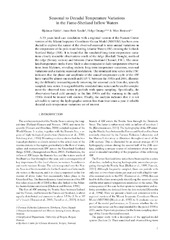Seasonal to Decadal Temperature Variations in the Faroe-Shetland Inflow Waters
Chapter
Permanent lenke
https://hdl.handle.net/1956/755Utgivelsesdato
2005Metadata
Vis full innførselSamlinger
- Geophysical Institute [1228]
Sammendrag
A 53 years hind-cast simulation with a regional version of the Nansen Center version of the Miami Isopycnic Coordinate Ocean Model (MICOM) has been conducted to explore the nature of the observed seasonal to inter-annual variations in the temperature of the pole-ward flowing Atlantic Water (AW) crossing the Iceland-Scotland Ridge (ISR). It is found that the simulated long-term temperature variations closely resemble observations south of the ridge (Rockall Trough), north of the ridge (Svinøy section) and between (Faroe Shetland Channel, FSC). The simulated temperature on the Faroe Shelf is also compared to daily temperature observations from Mykines, revealing realistic long-term temperature variations, seasonal variations and a realistic seasonal modulation. The simulated time series in the FSC indicates that the phase and amplitude of the annual temperature cycle of the AW have varied by almost one month and 0.15 ºC between the 1960s and 2001, illustrating the difficulty in unambiguously removing the seasonal cycle from the, sparsely sampled, time series. It is argued that the simulated time series can be used to complement the observed time series in periods with sparse sampling. Specifically, the observation-based cold anomaly in the late 1960s and the warming in the early 1980s should be treated with caution. Finally, the analysis indicates that it is not advisable to survey the hydrographic section less than four times a year if reliable decadal scale temperature variations are of interest.
